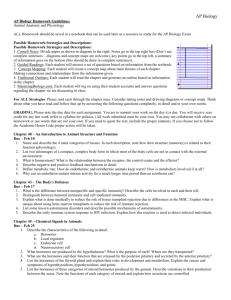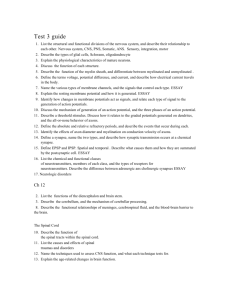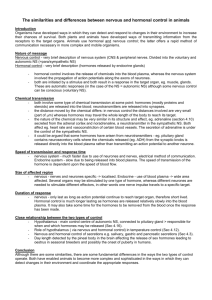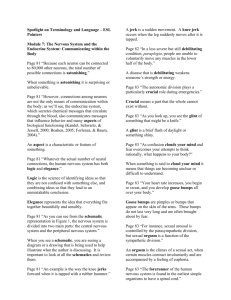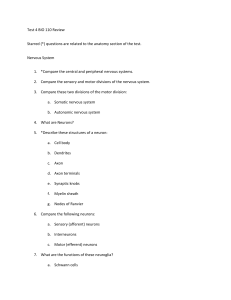Syllabus - Academic Departments
advertisement
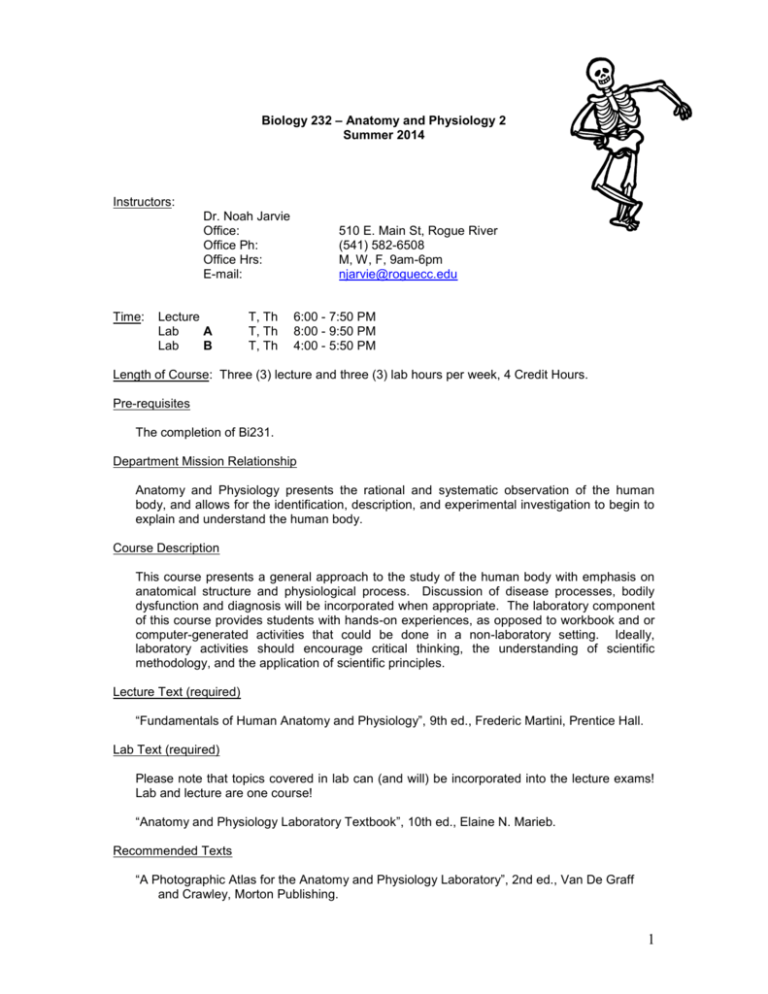
Biology 232 – Anatomy and Physiology 2 Summer 2014 Instructors: Dr. Noah Jarvie Office: Office Ph: Office Hrs: E-mail: Time: Lecture Lab A Lab B T, Th T, Th T, Th 510 E. Main St, Rogue River (541) 582-6508 M, W, F, 9am-6pm njarvie@roguecc.edu 6:00 - 7:50 PM 8:00 - 9:50 PM 4:00 - 5:50 PM Length of Course: Three (3) lecture and three (3) lab hours per week, 4 Credit Hours. Pre-requisites The completion of Bi231. Department Mission Relationship Anatomy and Physiology presents the rational and systematic observation of the human body, and allows for the identification, description, and experimental investigation to begin to explain and understand the human body. Course Description This course presents a general approach to the study of the human body with emphasis on anatomical structure and physiological process. Discussion of disease processes, bodily dysfunction and diagnosis will be incorporated when appropriate. The laboratory component of this course provides students with hands-on experiences, as opposed to workbook and or computer-generated activities that could be done in a non-laboratory setting. Ideally, laboratory activities should encourage critical thinking, the understanding of scientific methodology, and the application of scientific principles. Lecture Text (required) “Fundamentals of Human Anatomy and Physiology”, 9th ed., Frederic Martini, Prentice Hall. Lab Text (required) Please note that topics covered in lab can (and will) be incorporated into the lecture exams! Lab and lecture are one course! “Anatomy and Physiology Laboratory Textbook”, 10th ed., Elaine N. Marieb. Recommended Texts “A Photographic Atlas for the Anatomy and Physiology Laboratory”, 2nd ed., Van De Graff and Crawley, Morton Publishing. 1 Evaluation Though this class contains separate lecture and laboratory components, it will be taught as a single integrated course based upon completion of the following: Lecture Exam 1 Lecture Exam 2 Lecture Exam 3 100 points 100 points 100 points Lab Practical 1 Lab Practical 2 Lab Practical 3 50 points 50 points 50 points 300 150 Lab quizzes (6 at 10 points each) 60 points Reading Assignmt (6 at 5 points each) 30 points Article Assignment (1 at 30 points each) 30 points --------------------------------------------------------------------------------------------------------Total Points 570 points Grades will then be assigned on the percentage of points earned as given below: A B C D F 90-100 % 80-89.9 % 70-79.9 % 60-69.9 % <59.9% Please note that ALL exams are closed book (no notes, figures, drawings, texts, etc. may be used). The lecture exams will consist of approximately 60-70% multiple choice (bring a Scantron), 10-20% fill in the blank and/or matching, and 10% short answer (see Review Questions). The lab practicals will consist of short answer and/or fill in the blank, and may additionally include diagrams, models, and laboratory methods (not always the diagrams from texts). The weekly quizzes will consist of short answer questions and will be conducted the first fifteen minutes of the lecture class as listed in the course outline. They are to be a collaborative group effort, with groups consisting of 2-3 persons. All quizzes will be collected at the end of fifteen minutes. Please note that those late to lecture will not receive any extra time. Make-up Policy: only students with “legitimate” excuses (e.g., illness with a doctor’s note) may make up a lecture exam. However, any makeup work must be completed within a week following the regularly scheduled exam time and must have prior approval. Important: please note that due to the nature of laboratory work and laboratory practicals, if you miss a lab exam, regardless of the excuse, you will NOT be able to make it up. There will be NO exceptions! Be aware that plagiarism is not tolerated and will not be accepted. If you are unsure as to what constitutes plagiarism, please see your instructor as soon as possible for clarification. Attendance policy: as this course moves along quickly and the fact that lab and lecture are interdependent, it is critical that you attend all classes. Role will be taken in the form of a sign in sheet. It is YOUR responsibility to ensure that you sign this sheet each and every class. Please note however that you may earn 10 points of extra credit for PERFECT attendance!!! 2 Please feel free to discuss any assignment, or your grade, with me at any point in the term. I will be more than willing to help you in any way that I can in order for you to attain the level of success you want to achieve in this course. Animal Use Policy It is the policy of the RCC Science Department to utilize animal dissections in this course. Participation in these dissections is viewed as critical to the students learning of the subject matter and is required. If a student has personal moral and/or ethical conflicts with this policy, they should confer with the instructor as soon as possible to discuss their options. For more information please see: http://www2.rogue.cc.or.us/science/Academic_Standards/dissection.htm. Student Rights, Freedoms, and Responsibilities Upon enrollment for the course, it is expected that students have read, understood, and agreed to the Student Rights, Freedoms, and Responsibilities Statement the purpose of which is “to (1) identify fundamental provisions for students' freedom to learn, (2) identify student conduct guidelines, and (3) clarify expectations for student responsibility as expected by members of the College community.” Copies of this statement are available from the dean of Student and Community Services. In this document, it is stated that students will agree to practice academic honesty. Failure to abide by this statement may result in dismissal from the course. In addition, it is each student’s responsibility to be aware of all college procedures, including (but not limited to) how to add, drop, or withdraw from a class and the student services available to them. RCC’s Students Rights, Freedoms, and Responsibilities Statement may be found at: http://www.rogue.cc.or.us/BoardPolicies/appendix_3.htm The Science Department’s official Policy of Academic Standards may be found at: http://www2.rogue.cc.or.us/science/academicstandards.htm Students with Disabilities Any student who feels that she or he may need an academic accommodation for any disability, such as vision, hearing, orthopedic, learning disabilities, psychological or other medical conditions, should make an appointment with the Support Services Office. (Located in the Wiseman Tutoring Center at the Redwood Campus or Wards/G-207 at the Riverside Campus.) Syllabus Disclaimer A syllabus is designed to provide the student with a guide to course procedures, requirements, and grading policy. Sometimes it is necessary to alter the assignments or point totals. I reserve the right to alter the grade total + 10% or to change the assignments to deal with emergencies or materials issues as needed or to create a more productive learning program for student success. 3 Course Outline Bi232 Summer 14 RA=Reading Assignment Due Q=Lab Quiz Week 1 2 3 4 5 6 7 8 Date Jul 8 (T) Jul 10 (TH) Jul 15 (T) Jul 17 (Th) Jul 22 (T) Jul 24 (Th) Jul 29 (T) Jul 31 (Th) Aug 5 (T) Aug 7 (Th) Aug 12 (T) Aug 14 (Th) Aug 19 (T) Aug 21 (Th) Aug 26 (T) Aug 28 (Th) Lecture Syllabus, Spinal Cord and Nerves Spinal Cord and Nerves Brain & Cranial Nerves RA14 Brain & Cranial Nerves Sensory Pathways RA16 Exam 1 (Ch 13-15) Autonomic Nervous System Special Senses RA17 Special Senses Endocrine System RA18 Exam 2 (Ch 16-18) Blood Blood, Heart RA19 Heart Blood Vessels RA21 Exam 3 (Ch 19-21) Reading Ch 13 Ch 14 Ch 14 Ch 15 Ch 15 Ch 16 Ch 17 Ch 17 Ch 18 Ch 19 Ch 19 Ch 20 Ch 21 Lab Lab 19 Lab 21 Lab 17 (activity 1-3) Lab 17 (dissection) Lab 22 EXAM 1 (17,19,21,22) Lab 20,23,24 Lab 25 Lab 26 Lab 27, Lab 28b EXAM 2 (20,24-28b) Lab 29 Lab 30 Lab 31, Lab 32, Lab 33 EXAM 3 (29-33) Notes: 1. Reading Assignments will lose one point if turned in late. 2. In-class exams will be held during the regularly scheduled class time. Please bring a scantron form and a #2 pencil!!! This schedule is flexible and subject to change! 4 Q Q Q Q Q Q Biology 232 - Anatomy and Physiology 2 Lecture Review Questions 13. The Spinal Cord, Spinal Nerves and Spinal Reflexes 1. Discuss the structure and functions of the spinal cord. 2. Describe the three meningeal layers that surround the central nervous system. 3. Explain the roles of white matter and gray matter in processing and relaying sensory information and motor commands. 4. Describe the major components of a spinal nerve. 5. Relate the distribution pattern of spinal nerves to the regions they innervate. 6. Discuss the significance of neuronal pools and describe the major patterns of interaction among neurons within and among these pools. 7. Describe the steps in a neural reflex. 8. Classify the types of reflexes and explain the functions of each. 9. Distinguish among the types of motor responses produced by various reflexes. 10. Explain how reflexes interact to produce complex behaviors. 11. Explain how higher centers control and modify reflex responses. 14. The Brain and Cranial Nerves 1. Name the major regions of the brain and describe their functions. 2. Name the three primary brain vesicles and indicate which adult structures each gives rise to. 3. Name the ventricles of the brain and describe their locations and the connections between them. 4.Explain how the brain is protected and supported. 5. Discuss the formation, circulation, and functions of the cerebrospinal fluid. 6. Describe the anatomical differences between the medulla oblongata and the spinal cord. 7. List the main components of the medulla oblongata and specify their functions. 8.List the main components of the cerebellum and specify their functions. 9.List the main components of the mesencephalon and specify their functions. 10. List the main components of the diencephalons and specify their functions. 11. Identify the main components of the limbic system and specify their locations and functions. 5 12. Identify the major anatomical subdivisions of the cerebrum. 13. Locate the motor, sensory, and association areas of the cerebral cortex and discuss their functions. 14. Discuss the origin and significance of the major categories of brain waves seen in an electroencephalogram. 15.Describe representative examples of cranial reflexes that produce somatic responses or visceral responses to specific stimuli. 15. Neural Integration I: Sensory Pathways and the Somatic Nervous System 1. Specify the components of the afferent and efferent divisions of the nervous system and explain what is meant by the somatic nervous system. 2. Explain why receptors respond to specific stimuli, and how the organization of a receptor affects its sensitivity. 3. Identify the receptors for the general senses, and describe how they function. 4. Identify the major sensory pathways. 5. Explain how we can distinguish among sensations that originate in different areas of the body. 6. Describe the components, processes, and functions of the somatic motor pathways. 7. Describe the levels of information processing involved in motor control. 16. Neural Integration II: The Autonomic Nervous System and Higher-Order Functions 1.Compare the organization of the autonomic nervous system with that of the somatic nervous system. 2. List the divisions of the ANS and give the functions of each. 3. Describe the structures and functions of the sympathetic division of the autonomic nervous system. 4. Describe the mechanisms of neurotransmitter release in the sympathetic division. 5. Describe the effects of sympathetic neurotransmitters on target organs and tissues. 6. Describe the structures and functions of the parasympathetic division of the autonomic nervous system. 7. Describe the mechanisms of the neurotransmitter release in the parasympathetic division. 8. Describe the effects of parasympathetic neurotransmitters on target organs and tissues. 6 9. Discuss the relationship between the two divisions of the autonomic nervous system and the significance of dual innervation. 10. Explain the importance of autonomic tone. 11. Describe the hierarchy of interacting levels of control in the autonomic nervous system. 12. Define a visceral reflex and explain the significance of such reflexes. 13. Explain how memories are created, stored, and recalled. 14. Distinguish between the levels of consciousness and unconsciousness and identify the characteristics of brain activity associated with the different levels of sleep. 15. Describe some of the ways in which the interactions of the neurotransmitters influence brain function. 16. Summarize the effects of aging on the nervous system. 17. The Special Senses 1. Describe the sensory organs of smell and trace the olfactory pathways to their destinations in the brain. 2.Explain what is meant by olfactory discrimination and briefly describe the physiology involved. 3. Describe the sensory organs of taste and trace the gustatory pathways to their destinations in the brain. 4.Explain what is meant by gustatory discrimination and briefly describe the physiologic processes involved. 5. Identify the accessory structures of the eye and explain their functions. 6. Describe the internal structures of the eye and explain their functions. 7. Explain how we are able to distinguish colors and perceive depth. 8. Explain how light stimulates the production of nerve impulses and trace the visual pathways to their destinations in the brain. 9. Describe the structures of the external and middle ears and explain how they function. 10. Describe the parts of the inner ear and their roles in equilibrium and hearing. 11. Trace the pathways for the sensations of equilibrium and hearing to their respective destinations in the brain. 7 18. The Endocrine System 1. Explain the important of intercellular communication and describe the mechanisms involved. 2.Compare the modes of intercellular communication used by the endocrine and nervous systems and discuss the functional significance of the differences between the two systems. 3. Compare the cellular components of the endocrine system with those of other tissues and systems. 4. Compare the major structural classes of hormones. 5. Explain the general mechanisms of hormonal action. 6. Describe how endocrine organs are controlled. 7. Describe the location and structure of the pituitary gland and explain its structural and functional relationships with the hypothalamus. 8.Identify the hormones produced by the anterior and posterior lobes of the pituitary gland and specify the functions of those hormones. 9. Discuss the results of abnormal levels of pituitary hormone production. 10. Describe the location and structure of the thyroid gland. 11.Identify the hormones produced by the thyroid gland, specify the functions of those hormones, and discuss the results of abnormal levels of thyroid hormones. 12. Describe the location of the parathyroid glands, the functions of the hormone they produce, and the effects of abnormal levels of parathyroid hormone production. 13.Describe the location, structure, and general functions of the adrenal glands. 14. Identify the hormones produced by the adrenal cortex and medulla and specify the functions of each hormone. 15. Discuss the results of abnormal levels of adrenal hormone production. 16.Describe the location of the pineal gland and the functions of the hormone that it produces. 17. Describe the location and structure of the pancreas. 18. Identify the hormones produced by the pancreas, and specify the functions of those hormones. 19. Discuss the results of abnormal levels of pancreatic hormone production. 20. Describe the functions of the hormones produced by the kidneys, heart, thymus, testes, ovaries, and adipose tissue. 21.Explain how hormones interact to produce coordinated physiological responses. 22.Identify the hormones of special importance to normal growth and discuss their roles. 8 23. Define the general adaptation syndrome and compare homeostatic responses with stress responses. 24. Describe the effects of hormones on behavior. 19. Blood 1. List the components of the cardiovascular system and explain the major functions of this system. 2. Describe the important components and major functions of the blood. 3. Identify body sites used for blood collection and list the basic physical characteristics of the blood samples drawn from these locations. 4. Specify the composition and functions of plasma. 5. List the characteristics and functions of red blood cells. 6. Describe the structure of hemoglobin and indicate its functions. 7. Describe how the components of aged or damaged red blood cells are recycled. 8.Define erythropoiesis, identify the stages involved in red blood cell maturation, and describe the homeostatic regulation of red blood cell production. 9. Explain the importance of blood typing on the basis of ABO and Rh incompatibilities. 10. Categorize the various white blood cells on the basis of their structures and functions and discuss the factors that regulate production of each type. 11. Describe the structure, function and production of platelets. 12. Discuss mechanisms that control blood loss after an injury, and describe the reaction sequences responsible for blood clotting. 20. The Heart 1. Describe the organization of the cardiovascular system of the heart. 2. Describe the location and general features of the heart. 3. Describe the structure of the pericardium and explain its functions. 4. Trace the flow of blood through the heart, identifying the major blood vessels, chambers, and heart valves. 5. Identify the layers of the heart wall. 6. Describe the vascular supply to the heart. 7. Describe the events of an action potential in cardiac muscle and explain the importance of calcium ions to the contractile process. 9 8. Discuss the differences between nodal cells and conducting cells and describe the components and functions of the conducting system of the heart. 9. Identify the electrical events associated with a normal electrocardiogram. 10. Explain the events of the cardiac cycle, including atrial and ventricular systole and diastole, and relate the heart sounds to specific events in the cycle. 11. Define cardiac output, and describe the factors that influence this variable. 12.Describe the variables that influence heart rate. 13. Describe the variables that influence stroke volume. 14. Explain how adjustments in stroke volume and cardiac output are coordinated at different levels of activity. 21. Blood Vessels and Circulation 1. Distinguish among the types of blood vessels on the basis of their structure and function. 2. Describe how and where fluid and dissolved materials enter and leave the cardiovascular system. 3. Explain the mechanisms that regulate blood flow through arteries, capillaries, and veins. 4. Describe the factors that influence blood pressure and how blood pressure is regulated. 5. Discuss the mechanisms and various pressures involved in the movement of fluids between capillaries and interstitial spaces. 6. Describe how central and local control mechanisms interact to regulate blood flow and pressure in tissues. 7. Explain how the activities of the cardiac, vasomotor, and respiratory centers are coordinated to control blood flow through the tissues. 8. Explain how the cardiovascular system responds to the demands of exercise and hemorrhaging. 9. Identify the principal blood vessels and the functional characteristics of the special circulation to the brain, heart, and lungs. 10. Describe three general functional patterns seen in the pulmonary and systemic circuits of the cardiovascular system. 11. Identify the major arties and veins of the pulmonary circuit and the areas they serve. 12. Identify the major arteries and veins of the systemic circuit and the areas they serve. 13. Identify the differences between fetal and adult circulation patterns. 14. Describe the changes in the patterns of blood flow that occur at birth. 15. Discuss the effects of aging on the cardiovascular system. 10


